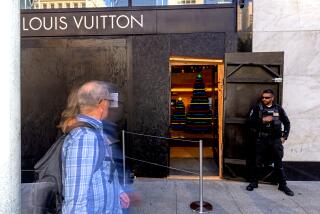Q&A: Why do people steal from stores?
- Share via
Why do people steal from stores, including the stores’ employees?
Richard Hollinger analyzes that question for a living. He’s a criminology professor at the University of Florida who also leads an annual study of retail theft jointly conducted by the school and the National Retail Federation, the industry’s trade group.
The latest study, revealed last month at the NRF’s convention in Long Beach, showed that theft and other so-called “shrink” cost retailers $44 billion last year. The two main culprits: shoplifting and employee stealing.
The good news: As stores use more technology and other means to deter theft, nearly two-thirds of U.S. retailers said their theft-related losses either fell or held steady in 2014 compared with the prior year.
We asked Hollinger to explain further why retail theft occurs. Here’s an excerpt of the discussion:
Can you put the $44-billion loss in context?
There is no form of property crime in America that adds up to $44 billion a year. Bank robberies, household burglary, auto theft, none of them. In fact, if you add all of those up, they don’t get close to $44 billion a year.
The $44 billion lost overall is called “shrink,” and it was 1.38% of total retail sales. The biggest component was shoplifting at 38%, then employee theft at 34.5%. The rest includes administrative and paperwork errors and vendor fraud, among other things.
The retailers, by the way, include everything from big department stores to specialty stores and supermarkets.
Why is shoplifting such a big piece?
Remember, the shoplifting includes organized crimes of theft. They’re largely taking stuff they know they can turn around and sell or fence. Or they’ll bring the items back to the store in exchange for gift cards and they’ll sell the cards on Internet auction sites, so they victimize the store twice.
What are some of the items they want?
Over-the-counter pain relievers, and not the stores’ brands — they want the main brand names for resale. Baby formula is desirable, along with batteries, disposable razors and women’s makeup, especially the high-end brands. Cigarettes, consumer electronics and jewelry also are popular. These are the kind of things that can easily be stuck into pockets and be put in small bags and taken out of the store.
But what about those tags and electronic codes on products that are supposed to set off alarms if you steal?
The pros will bring in what are called booster bags. They’re aluminum-lined bags, and the alarms won’t go off. Or they’re bold enough that they’ll run out the door to a waiting van and drive off.
What about the non-professionals?
They come in all shapes and sizes, from teenagers to low-income folks, and they are easier to deter. They see the anti-theft devices the retailers have in place and are more likely to think they’ll be caught.
There are still impulse shoplifters and they generally steal items to use or consume. But it’s the organized groups that make the retailers shudder.
On the employee-theft side, why do workers steal?
It’s a sad reality, but usually when they feel inadequately paid or compensated they take action in their own way to give themselves a “raise.” This happens in all sectors of business, not just in retail.
One of the ways employees get back at this perceived injustice is by not working as hard, what we call counterproductive behavior. Another way is to actually steal from the workplace.
What is the form of worker theft called “sweetheart” or “hybrid” theft?
It’s stealing with or for someone else. Let’s suppose I work at a retail store as a cashier and you’re my friend. You come in to shop and I appear to check you out by waving your items over the computer scanner. But I’m not close enough for the computer to actually scan them. You walk out the door. It looks like a transaction has occurred but it hasn’t.
Are there other ways employees can rip off stores?
They know how to get around the technology. They know how to turn off the cameras and other anti-theft devices.
How are retailers fighting all this?
Many stores already require employees to empty their pockets, purses, drink containers and so forth when they leave for the day.
One new method is the increasing use of cameras linked to software that will be able to signal certain types of shopping behavior in real time to the retailers’ managers and loss-prevention personnel. For instance, they’ll be able to know when an item passes over the checkout scanner and it doesn’t beep, or if you take a whole shelf of pain medicine but haven’t yet walked out the door. The system can instantly signal to store personnel that somebody just cleaned out all the Advil in Aisle 3.
How do retailers make up for the lost $44 billion?
It’s not just the retailers that suffer. They have to make a profit, so we the consumers suffer, too. So do the employees. The stores increase prices of goods, they limit hours for employees or do whatever else to cover the losses. It’s a crime that affects us all.
Twitter: @PeltzLATimes
More to Read
Inside the business of entertainment
The Wide Shot brings you news, analysis and insights on everything from streaming wars to production — and what it all means for the future.
You may occasionally receive promotional content from the Los Angeles Times.











